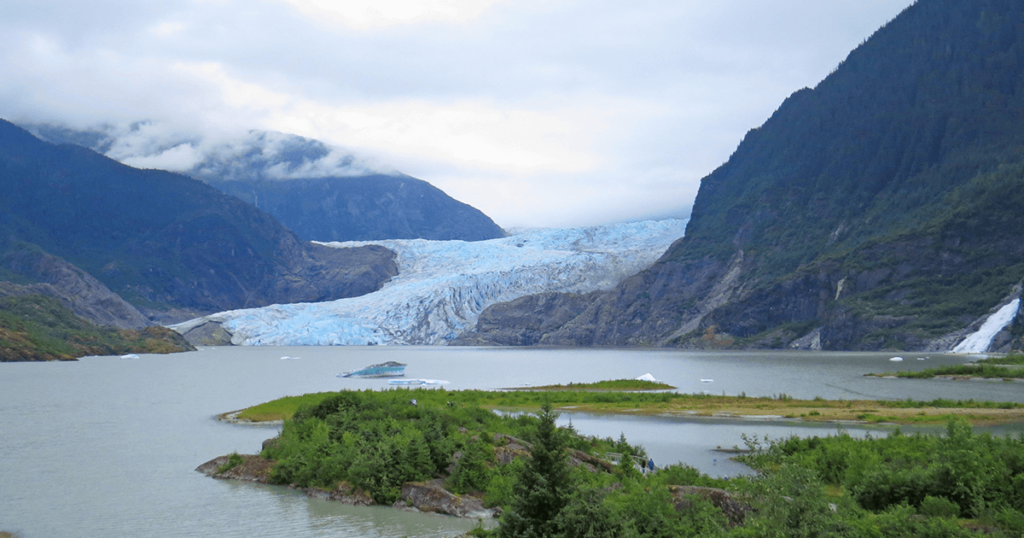
I flew to southeast Alaska two decades ago straight into a fight among U.S. Forest Service officials, environmentalists, politicians, and investors over how many trees could be cut in the Tongass National Forest and under what conditions. It was a complicated story that went all the way back to Teddy Roosevelt, who established the protected area in 1902, our largest national forest and a source of interest to such disparate Americans as William Henry Seward, John Muir, and General Douglas MacArthur.
The Tlingit word rings like struck bronze—Tongass—and denotes most of the Alexander Archipelago, a sloping handle of southeast Alaska fused to British Columbia by glaciers and deep valleys. It harbors, in addition to gorgeous coastal peaks, immense forested slopes, muskegs reflecting like mirror shards, and braided streams feeding an inland extension of the Pacific Ocean.
Many of its beaches are defined by bleached logs—Sitka spruce, hemlock, and cedar—and all of its 17 million acres are under the aegis of the United States Forest Service. Lately, the question has again arisen as to how a federal agency—the Department of Agriculture, of which the Forest Service is part—can go against the wisdom of many of its own biologists, as well as the views of many American citizens in the long aftermath of the Exxon Valdez, the BP Gulf of Mexico oil spill, and ongoing environmental degradation?
Americans should be more familiar with the Tongass, the world’s largest intact temperate rainforest and home to the world’s largest concentration of brown bears, which surpass in size even their grizzly cousins to the south. There are also distinct subspecies, like the Alexander Archipelago wolf; wild coho, king, and sockeye salmon like those that once thronged the Columbia and Snake rivers; and birds steadily winging over the threshold of the Endangered Species Act, including the marbled murrelet and the northern goshawk.
MacArthur allowed the bargain-basement cutting and shipping of the Tongass’s rare timber to Japan when he was that nation’s unofficial grand satrap after World War II, a dark period for the Tongass. Remnants of the companies that did this work controlled much of the cut for decades, leaving behind toxic mill sites that still need cleaning up.
Fortunately, much of the forest has been protected since 2001 by the Roadless Rule, which prevented loggers from carving out new trucking corridors, and cutting rare Sitka spruce and other huge trees. But that is about to change.
Forest Service lands harbor what writer and environmentalist Edward Abbey called the last of old-time America. By that he meant a wild vastness where Americans can pay homage to nature but also hunt, forage, and even mine as they have since the beginning of our democracy, contributing for better or for worse to what it means to be American.
The historian Frederick Jackson Turner pointed out in his famous 1893 speech, “The Significance of the Frontier in American History,” that the American character was formed by dealing with the frontier. It fostered self-sufficiency and egalitarianism, and arguably still does. “American democracy was born of no theorist’s dream … nor in the Mayflower to Plymouth,” said Turner. “It came out of the American forest.”
Today standing trees on a prodigious scale inspire a broad spectrum of Americans, from tourists to back-packers. In the age of global warming, they have acquired an additional preciousness in that they absorb carbon dioxide and replenish breathable air. But despite all of this (and apparently emboldened by the present administration’s attacks on development restraints across the board), the Forest Service has decided to reject the heretofore sacrosanct Roadless Rule.
In what appears to be a demonstration of democracy, the Forest Service has come up with no less than six proposals to build new roads and increase the cut. These proposals are open to comment by the public and the Forest Service will announce its decision in June 2020. All the proposals but the first would result in more logging, and the significant diminishment of America’s largest forest and the things that thrive in it—with the notable exception of the timber companies.
If the Forest Service’s stated preference is adopted, which seems likely, it would “return decision-making authority to the Forest Service, allowing decisions concerning timber harvest, road construction, and roadless area management … to be made by local officials on a case-by-case basis.” This means that citizens and environmental groups will have little say and the timber industry can revert to its old ways of cutting roads – at taxpayers’ expense – through vast domains of relatively unspoiled land without restraint.
The Tongass has long been a stepping stone up for Forest Service managers capable of pushing “the cut.” The blatant advocacy of over-riding of the near sacrosanct Roadless Rule has pleased local elected officials and timber companies that would potentially profit greatly from such a change. Alaska’s governor, Michael Dunleavy hailed the announcement of the prospective demise of the Roadless Rule in the Tongass as “further proof that Alaska’s economic outlook is looking brighter every day.”
It’s looking brighter in part because those who have been pursuing the bounty of the Tongass for close to a century will have easier, cheaper access to old growth timber that many Americans want preserved. We all depend on agencies like the Department of Agriculture to husband these diminishing resources.
The public comment period ends in December. Americans thus have a short time to comment on such a momentous change. But they must—because, after all, the Tongass belongs to them.

